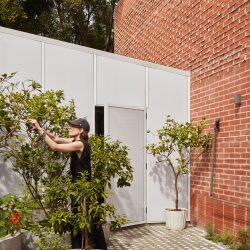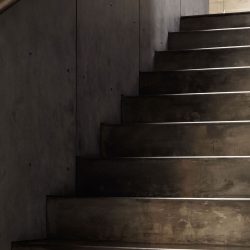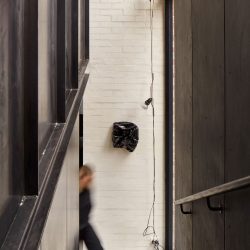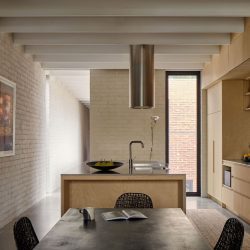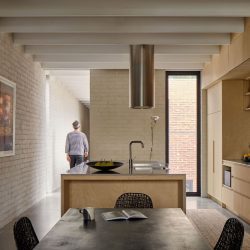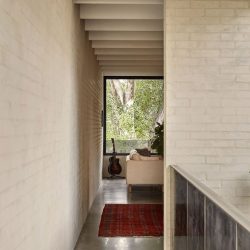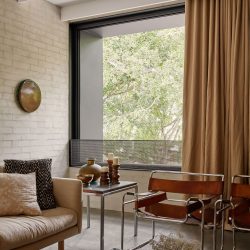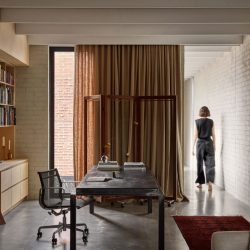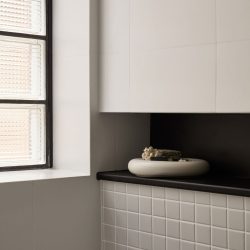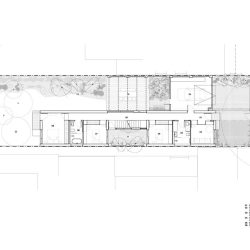
Studio Roam . With Architecture . photos: © Jack Lovel
For the clients, as Architects, the project was the culmination of many years of gathering sketches, design ideas, artwork, objects, and references of the work of their architectural icons. Because of this, the brief seemed to require as much from the past as it did from the future, as a place to hold a treasure trove of family memories and stories as well as a building to enrich each moment of the humble drum of day-to-day life.
The design and build process was always highly collaborative with multiple design-focused thinkers working together at any one time. The clients were highly engaged and committed to the clarity of the design ideas. This shared vision throughout the project afforded us a delightful working relationship, and in the process of making a building we fostered a dear friendship.
The site is located on the northern side of a well renowned street in inner suburban Perth ~ iconic for the dense canopy of fig trees that line both sides of the street.
With the demolition of the existing cottage, the lot was reconfigured with a life-long masterplan in mind. The project is the first of two terrace houses envisaged for the site. With the removal of the lightweight garage structure and patio deck, the second terrace house would be a mirror image in plan. A family legacy to eventually be passed to the clients’ two children.
The equal division of the site, allowing for future development, resulted in two narrow allotments, each with their own set of variables and conditions to consider. The first lot was to contain the building footprint, maximising the 5m width and the other would contain a temporary long skinny garden, with outdoor entertaining areas and a double garage, all of which could be easily dismantled and removed in the future.
The design of the terrace house implemented temporary and easily amended modifications along the eastern façade that would allow access and views out to enjoy the garden in the short-term.
The long elevations of the house were treated as large scale tapestries, and we explored pattern and texture through the use of mortar. The weeping, oozy mortar gave the building a kind of crusty crown that we expect, overtime will patina and stain with the falling debris from the fig tree canopy. Although this finish has proven to be divisive among onlookers, the clients have been delighted by the incidental design discussion the house has initiated.
Many studies of the facades were conducted to test the composition and articulation of the end elevations. The large window boxes, one facing Mary street and the other to the rear garden, gesture to the tree canopies at each end and invite a more intimate connection and relationship with the garden and street below. Since moving in the clients have often found themselves in conversation with passers-by as they sit in the window on the street.
Throughout the design process there was always a strong motivation to maintain the honesty and integrity of the materials. This was always rigorously pursued in the architectural detailing and interiors. The materials are common and conventional but rely heavily on the craftsmanship of each trade. Every brick and every weld are on display as the finished surface.
The decision to use humble and common materials is most evident in the use of the utility brick throughout. Typically cover by render or paint, this humble brick in its raw state celebrates the true craftsmanship of the bricklayer and builder.
The floor plan is compact and there is a simplicity to the arrangement of spaces across both floors. Plywood cabinetry runs the length of the entry corridor, dividing rooms on ground level into cave-like private spaces. On the upper level this language is repeated, and the plywood cabinetry acts as a functional spine to the kitchen, dining and living spaces.
A sculptural mild-steel staircase acts as the centrepiece of the building running parallel to a small courtyard garden. This allows light, air, and views to penetrate the elongated plan and invites a figurative and literal dialogue between adjacent spaces.
_








